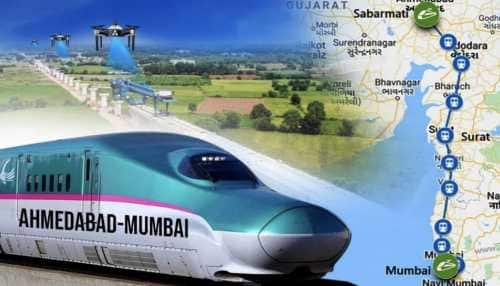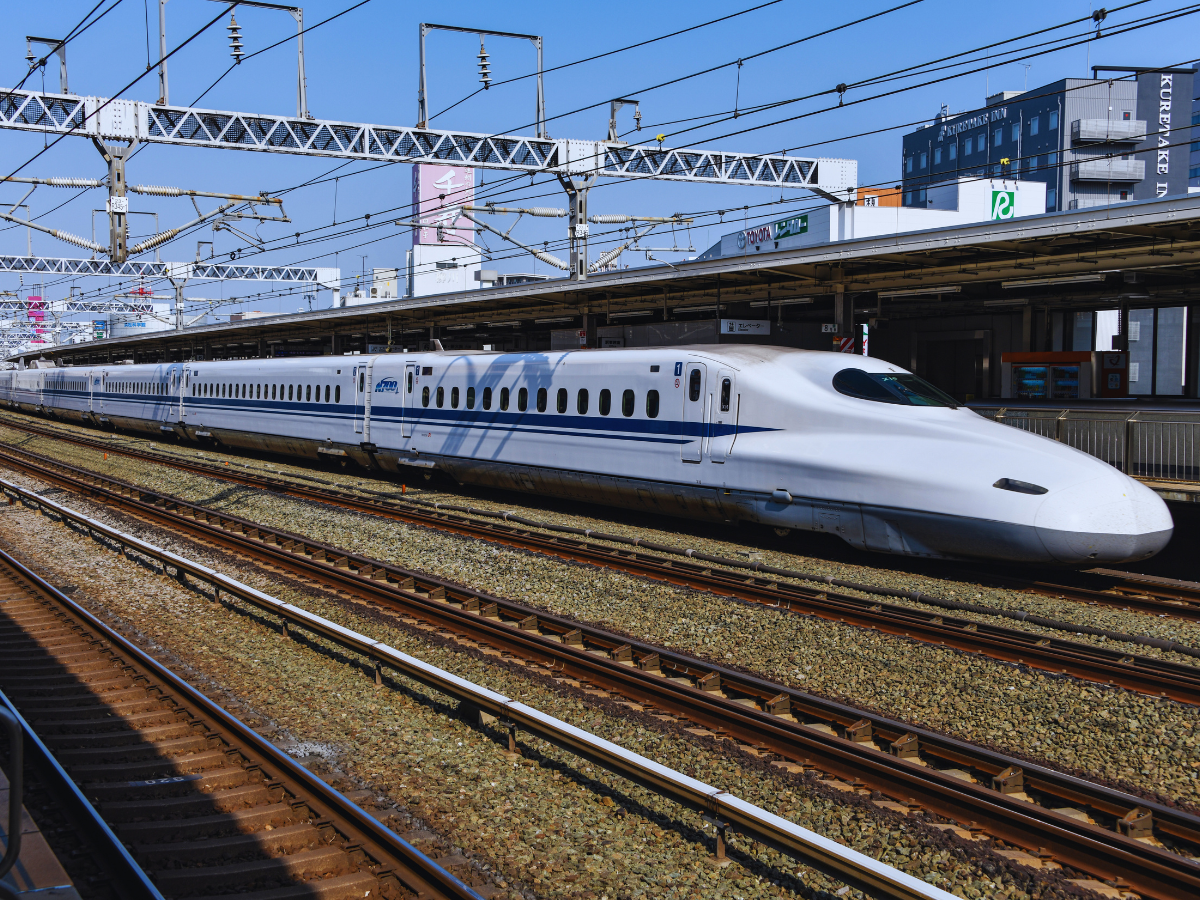India is poised to make history with its first-ever bullet train, connecting the bustling city of Mumbai to Ahmedabad. This ambitious high-speed rail project promises to revolutionize long-distance travel, slashing the current journey time from seven hours to just over two hours. Using cutting-edge Japanese Shinkansen technology, this venture represents a monumental step forward in India’s infrastructure development. The Mumbai–Ahmedabad Bullet Train isn’t just a transport project; it’s a symbol of India’s aspirations to embrace speed, efficiency, and futuristic urban connectivity, marking the dawn of a new era in the country’s transportation narrative.
The Mumbai–Ahmedabad Bullet Train project incorporates several eco-friendly initiatives aimed at minimizing its environmental footprint. With a focus on sustainability, energy-efficient technologies such as regenerative braking systems will be deployed to reduce power consumption. Viaduct construction avoids large-scale land disruption, preserving farmlands and reducing deforestation. The project’s electrified rail operations significantly lower carbon emissions compared to road or air travel on the same route. Additionally, noise barriers and vibration control technologies are being implemented to protect local ecosystems. These initiatives align with India’s broader commitment to green infrastructure and environmentally conscious development strategies.
Massive Job Creation Potential
The bullet train project is a significant employment generator, expected to create over 90,000 direct and indirect jobs during its construction and operational phases. This includes roles in civil engineering, mechanical work, signalling, operations, and maintenance. Additionally, ancillary industries such as construction materials, logistics, and local vendors will benefit from increased demand. Specialized training programs have been initiated to develop a skilled workforce proficient in high-speed rail technologies. The project is not just a transport revolution; it is a catalyst for large-scale socio-economic upliftment, providing new livelihood opportunities across Maharashtra and Gujarat.
Boost to Make in India Vision
A cornerstone of the Mumbai–Ahmedabad Bullet Train project is its alignment with the “Make in India” initiative. Several critical components, including train body parts, track systems, and electrical components, are being progressively localized. Japanese firms are partnering with Indian manufacturers for technology transfers, fostering domestic production capabilities in high-speed rail technologies. This collaboration is expected to boost India’s engineering and manufacturing sectors, creating a robust ecosystem for future rail infrastructure projects. The bullet train thus represents not just imported technology but a strategic investment in India’s industrial self-reliance and long-term technological competitiveness.
Economic Corridors & Urban Expansion
The high-speed corridor will unlock significant urban expansion along its route. Cities like Surat, Vadodara, and Vapi are projected to emerge as key economic hubs, attracting investments in real estate, manufacturing, and services. Enhanced connectivity will facilitate the development of satellite towns, reduce urban congestion in mega-cities like Mumbai, and stimulate balanced regional growth. Business parks, educational institutions, and logistics centres are expected to mushroom around the bullet train stations, transforming these zones into economic corridors that foster employment and entrepreneurship. The project is a major enabler of urban decongestion and regional integration.
Passenger Experience Innovations
The bullet train promises a superior passenger experience with cutting-edge amenities designed for comfort, safety, and efficiency. The coaches will feature ergonomic seating, Wi-Fi connectivity, onboard infotainment, and spacious luggage racks. Advanced ticketing systems will ensure seamless boarding through biometric authentication and smart card access. Special attention is being given to ensure universal accessibility for differently-abled passengers. Additionally, real-time journey updates, high hygiene standards, and enhanced safety protocols will be integral to operations. The emphasis on passenger convenience aims to deliver a travel experience on par with the world’s most advanced high-speed rail services.
Revolutionizing Business & Tourism Connectivity
The Mumbai–Ahmedabad Bullet Train is expected to dramatically enhance business and tourism connectivity between the two economic powerhouses. Business travellers will benefit from faster, more reliable commutes, enabling same-day return trips and increased productivity. The shortened travel time is also expected to stimulate weekend tourism, benefiting destinations like Daman, Diu, and Gir National Park. Hotels, travel agencies, and local artisans stand to gain from the surge in tourist footfalls. This improved connectivity will facilitate greater cultural exchange and economic interdependence between Maharashtra and Gujarat, reinforcing the symbiotic relationship between commerce and tourism.
Technological Innovations in Tunneling & Engineering
The project showcases India’s engineering prowess with its successful completion of complex tunneling work beneath Thane Creek, marking the country’s first undersea rail tunnel. Innovative methods like New Austrian Tunneling Method (NATM) and advanced Tunnel Boring Machines (TBMs) were deployed to execute this engineering feat with precision. The viaducts, designed to withstand seismic activity, incorporate cutting-edge materials and construction techniques to ensure long-term durability. These technological innovations not only push the boundaries of Indian infrastructure capabilities but also lay the groundwork for future projects involving challenging terrain and high-density urban environments.
India’s High-Speed Rail Ambitions Beyond 2029
The Mumbai–Ahmedabad Bullet Train is envisaged as the precursor to a larger national high-speed rail network. Future projects under planning include corridors connecting Delhi–Ahmedabad, Mumbai–Nagpur, and Delhi–Varanasi, aiming to establish India as a global leader in rail-based mass transit. The successful execution of this inaugural project will serve as a benchmark, accelerating approvals and investments for subsequent ventures. India’s foray into bullet trains is more than a transport upgrade—it is a statement of ambition, technological advancement, and a pivotal step towards reshaping the country’s infrastructural and economic trajectory for the next generation.


Construction Progress & Milestones
The construction of the 508 km Mumbai–Ahmedabad corridor is progressing rapidly, achieving significant milestones. Over 300 km of viaducts have already been constructed using advanced engineering methods like the Full Span Launching Method (FSLM). Massive undersea tunneling work through Thane Creek has been completed, a pioneering feat in India’s rail infrastructure history. The assembly of bridge segments, completion of pillars, and rapid installation of track infrastructure are ahead of schedule. Each construction phase exemplifies India’s growing expertise in managing complex, large-scale infrastructure projects while maintaining international standards of precision and efficiency.
Phased Commissioning Timeline
The project will be implemented in phases, with the Gujarat stretch between Vapi and Sabarmati expected to be operational by December 2027. Full completion of the corridor, including the Maharashtra segment, is slated for December 2029. However, there are efforts to expedite a partial rollout, with a section between Surat and Ahmedabad potentially opening as early as 2026. This phased commissioning strategy aims to deliver early benefits to commuters while maintaining a rigorous quality check process across remaining sections. The phased approach balances ambition with pragmatism, ensuring a smooth and safe launch.
Stations & Route Overview
The bullet train will connect 12 strategically located stations: Bandra Kurla Complex, Thane, Virar, Boisar, Vapi, Bilimora, Surat, Bharuch, Vadodara, Anand, Ahmedabad, and Sabarmati. These stations are designed to be modern, efficient, and seamlessly integrated with existing urban transit systems. The BKC station, positioned 32.5 metres underground, will be a structural marvel, built to support high-rise buildings above it. This comprehensive route plan aims to unlock economic synergies across Maharashtra and Gujarat, linking industrial hubs, commercial centers, and residential zones in a high-speed transit ecosystem that redefines regional connectivity.
Speed, Safety & Signalling
Operating at a top speed of 320 km/h, the Mumbai–Ahmedabad Bullet Train will introduce India to world-class high-speed rail technology. Equipped with advanced European Train Control System (ETCS) Level-2 signalling, the corridor will ensure maximum safety through real-time communication-based control systems. These state-of-the-art signalling systems guarantee high operational efficiency, enabling safe, high-frequency train services with minimal risk of human error. The trainsets will feature earthquake detection systems, automated braking, and advanced track monitoring, ensuring that India’s first bullet train adheres to the highest global safety benchmarks and delivers a secure travel experience.

Japanese Partnership & Train Sets
Japan’s technological collaboration plays a crucial role in this landmark project. Two Shinkansen train sets will be gifted to India for early trial runs, helping in fine-tuning operations for Indian environmental conditions. The long-term plan includes deploying the E10 series Shinkansen models, manufactured under India’s “Make in India” initiative with Japanese technical assistance. This partnership not only brings cutting-edge bullet train technology but also emphasizes knowledge transfer, fostering indigenous capability building. The synergy between Indian execution and Japanese precision is expected to elevate India’s standing in the global high-speed rail ecosystem.
Funding & Economic Implications
The project’s total estimated cost stands at ₹1.08 lakh crore, with 81% of the funding provided through low-interest loans from the Japan International Cooperation Agency (JICA). This massive investment is projected to spur extensive economic development along the corridor, creating new employment opportunities, enhancing trade logistics, and stimulating regional industries. Cities along the bullet train route are expected to witness significant urban rejuvenation, with new business districts, residential complexes, and industrial parks emerging, driven by improved connectivity. The economic multiplier effect of this infrastructure venture is poised to transform Western India’s economic landscape.
 Regional Integration & Future Outlook
Regional Integration & Future Outlook
Once operational, the Mumbai–Ahmedabad Bullet Train will integrate two of India’s most vital economic corridors, reducing the travel time dramatically and fostering greater inter-city collaboration. Beyond immediate transport convenience, this project lays the foundation for future high-speed rail ventures, including planned corridors like Delhi–Ahmedabad and Mumbai–Nagpur. It’s a critical step in realizing India’s ambition of creating a national network of bullet trains. As India modernizes its rail infrastructure, the success of this project will serve as a blueprint for future transport initiatives that prioritize speed, safety, environmental sustainability, and economic inclusivity.
Follow: IRCTC
Also read: Home | Channel 6 Network – Latest News, Breaking Updates: Politics, Business, Tech & More

